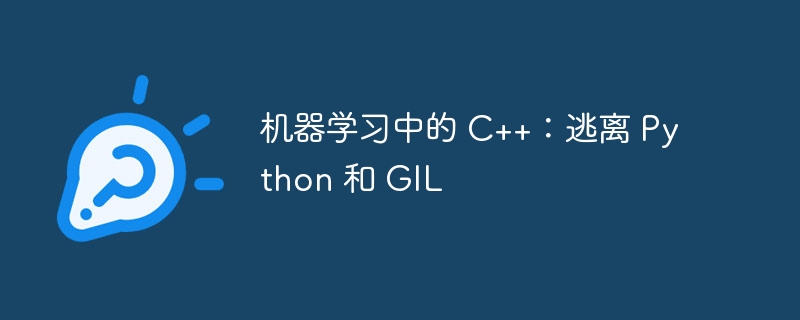
介绍
当 olor:#f60; text-decoration:underline;’ href=”https://www.php.cn/zt/15730.html” target=”_blank”>python 的全局解释器锁 (gil) 成为需要高并发或原始性能的机器学习应用程序的瓶颈时,c++ 提供了一个引人注目的替代方案。这篇博文探讨了如何利用 c++ 进行机器学习,重点关注性能、并发性以及与 python 的集成。
阅读完整的博客!
了解 gil 瓶颈
在深入研究 c++ 之前,让我们先澄清一下 gil 的影响:
-
并发限制:gil 确保一次只有一个线程执行 python 字节码,这会严重限制多线程环境中的性能。
-
受影响的用例:实时分析、高频交易或密集模拟中的应用程序经常受到此限制。
立即学习“”;
为什么选择 c++ 进行机器学习?
-
没有 gil:c++ 没有与 gil 等效的东西,允许真正的多线程。
-
性能:直接内存管理和优化功能可以带来显着的加速。
-
控制:对硬件资源的细粒度控制,对于嵌入式系统或与专用硬件连接时至关重要。
代码示例和实现
设置环境
在我们编码之前,请确保您拥有:
- 现代 c++ 编译器(gcc、clang)。
- 用于项目管理的 cmake(可选但推荐)。
- 像 eigen 这样的用于线性代数运算的库。
c++ 中的基本线性回归
#include <vector> #include <iostream> #include <cmath> class linearregression { public: double slope = 0.0, intercept = 0.0; void fit(const std::vector<double>& x, const std::vector<double>& y) { if (x.size() != y.size()) throw std::invalid_argument("data mismatch"); double sum_x = 0, sum_y = 0, sum_xy = 0, sum_xx = 0; for (size_t i = 0; i x = {1, 2, 3, 4, 5}; std::vector<double> y = {2, 4, 5, 4, 5}; lr.fit(x, y); std::cout <h3> 使用 openmp 进行并行训练 </h3> <p>展示并发性:<br></p> <pre class="brush:php;toolbar:false">#include <omp.h> #include <vector> void parallelfit(const std::vector<double>& x, const std::vector<double>& y, double& slope, double& intercept) { #pragma omp parallel { double local_sum_x = 0, local_sum_y = 0, local_sum_xy = 0, local_sum_xx = 0; #pragma omp for nowait for (int i = 0; i <h3> 使用特征值进行矩阵运算 </h3> <p>对于逻辑回归等更复杂的操作:<br></p> <pre class="brush:php;toolbar:false">#include <eigen> #include <iostream> eigen::vectorxd sigmoid(const eigen::vectorxd& z) { return 1.0 / (1.0 + (-z.array()).exp()); } eigen::vectorxd logisticregressionfit(const eigen::matrixxd& x, const eigen::vectorxd& y, int iterations) { eigen::vectorxd theta = eigen::vectorxd::zero(x.cols()); for (int i = 0; i <h2> 与python集成 </h2> <p>对于 python 集成,请考虑使用 pybind11:<br></p> <pre class="brush:php;toolbar:false">#include <pybind11> #include <pybind11> #include "your_ml_class.h" namespace py = pybind11; pybind11_module(ml_module, m) { py::class_<yourmlclass>(m, "yourmlclass") .def(py::init()) .def("fit", &yourmlclass::fit) .def("predict", &yourmlclass::predict); } </yourmlclass></pybind11></pybind11>
这允许您从 python 调用 c++ 代码,如下所示:
import ml_module model = ml_module.YourMLClass() model.fit(X_train, y_train) predictions = model.predict(X_test)
挑战与解决方案
-
内存管理:使用智能指针或自定义内存分配器来高效、安全地管理内存。
-
错误处理:c++ 没有 python 的异常处理来进行开箱即用的错误管理。实施强大的异常处理。
-
库支持:虽然 c++ 的 ml 库比 python 少,但 dlib、shark 和 mlpack 等项目提供了强大的替代方案。
结论
c++ 提供了一种绕过 python 的 gil 限制的途径,为性能关键的 ml 应用程序提供了可扩展性。虽然由于其较低级别的性质,它需要更仔细的编码,但速度、控制和并发性方面的好处可能是巨大的。随着 ml 应用程序不断突破界限,c++ 仍然是 ml 工程师工具包中的重要工具,尤其是与 python 结合使用以方便使用时。
进一步探索
- simd 操作:研究如何使用 avx、sse 来获得更大的性能提升。
- cuda for c++:用于 ml 任务中的 gpu 加速。
- 高级 ml 算法:用 c++ 实现神经网络或 svm,以实现性能关键型应用。
感谢您与我一起深入研究!
感谢您花时间与我们一起探索 c++ 在机器学习方面的巨大潜力。我希望这次旅程不仅能够启发您克服 python 的 gil 限制,还能激励您在下一个 ml 项目中尝试使用 c++。您对学习和突破技术极限的奉献精神是推动创新前进的动力。不断尝试,不断学习,最重要的是,不断与社区分享您的见解。在我们下一次深入研究之前,祝您编码愉快!
以上就是机器学习中的 C++:逃离 Python 和 GIL的详细内容,更多请关注php中文网其它相关文章!
 微信扫一扫打赏
微信扫一扫打赏
 支付宝扫一扫打赏
支付宝扫一扫打赏

